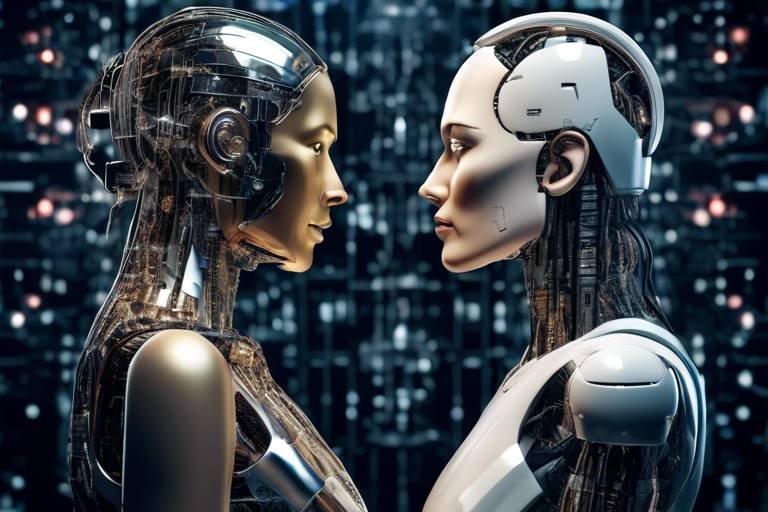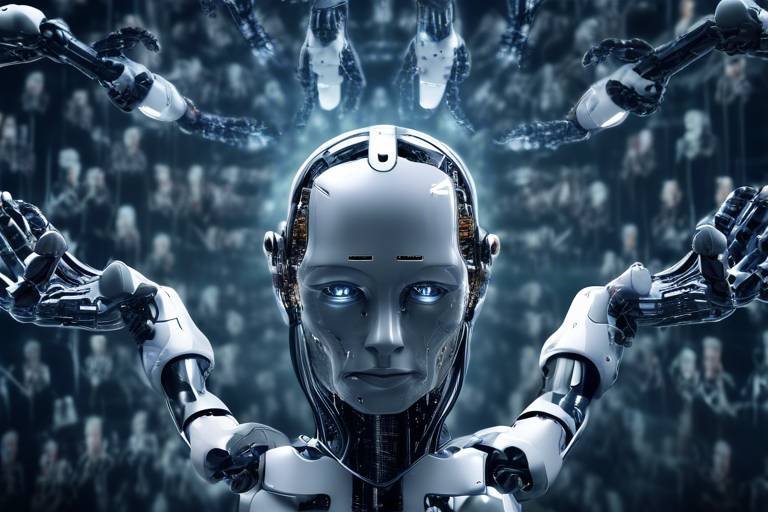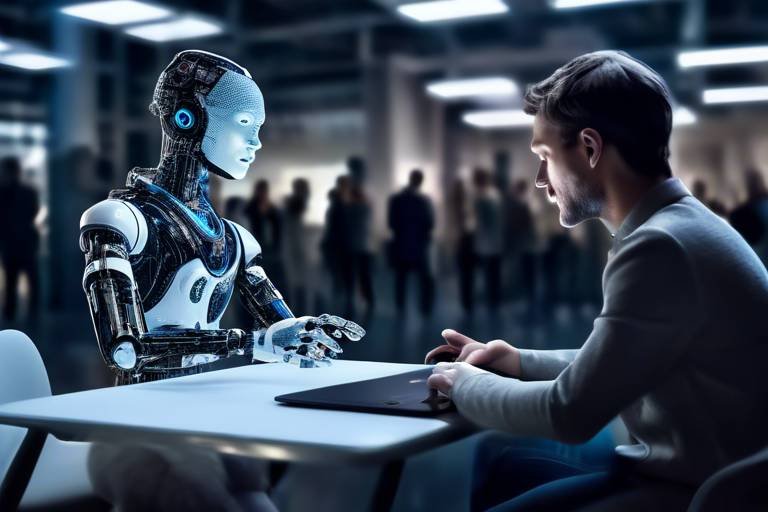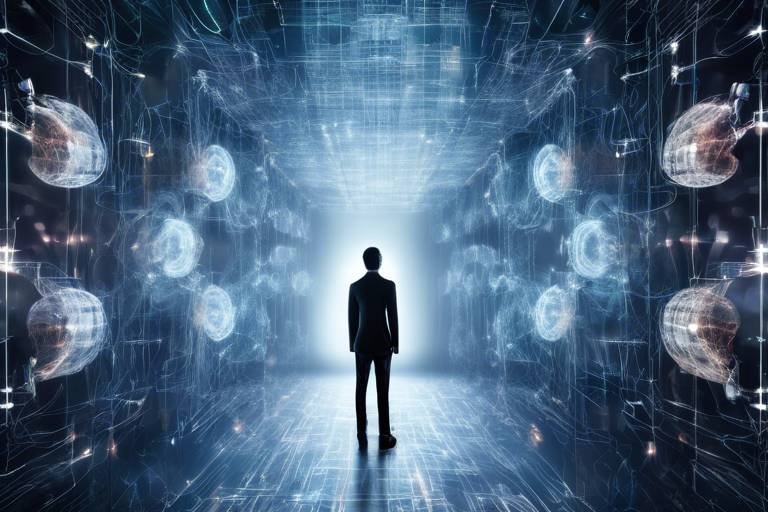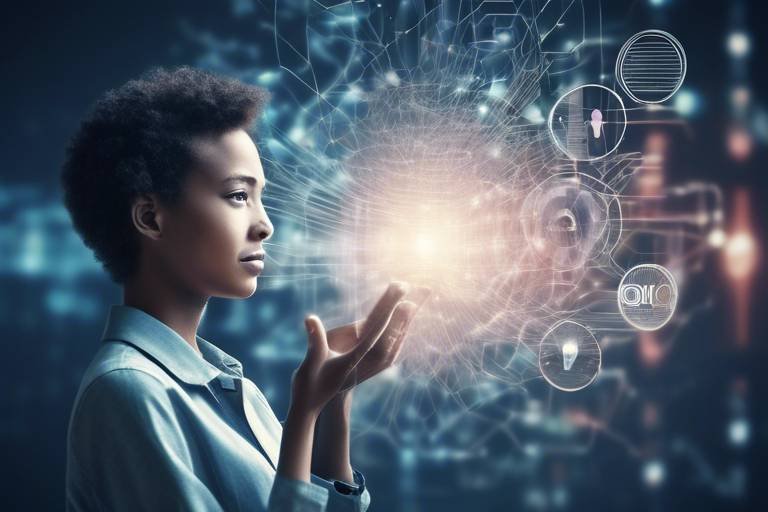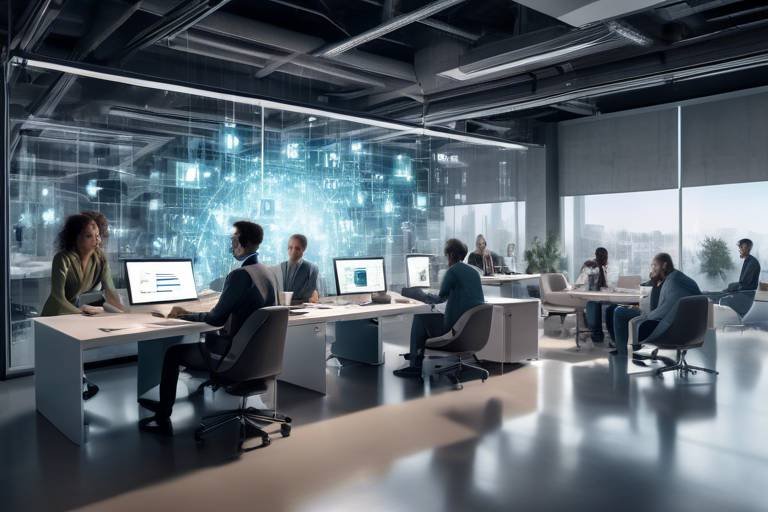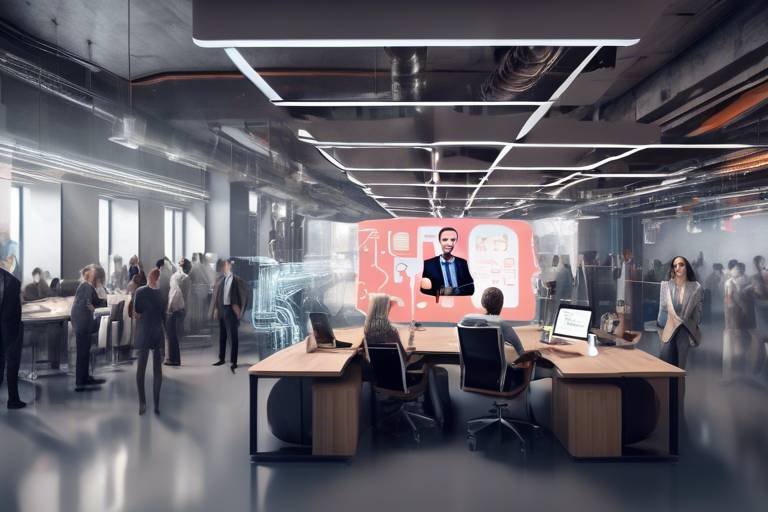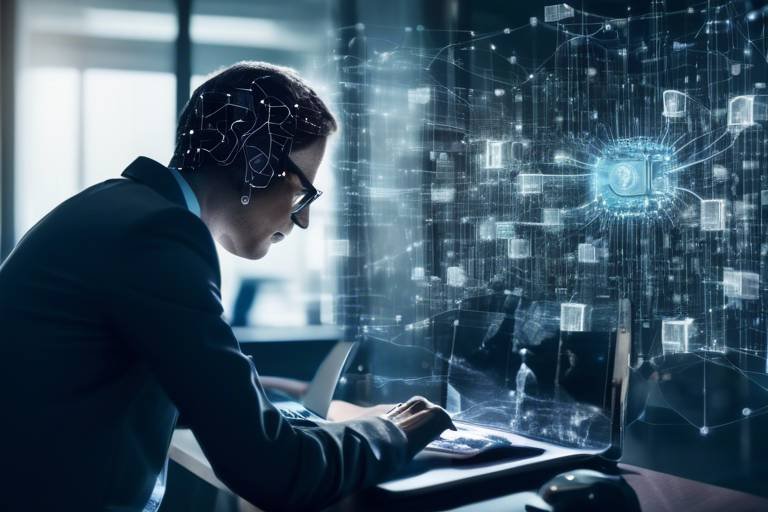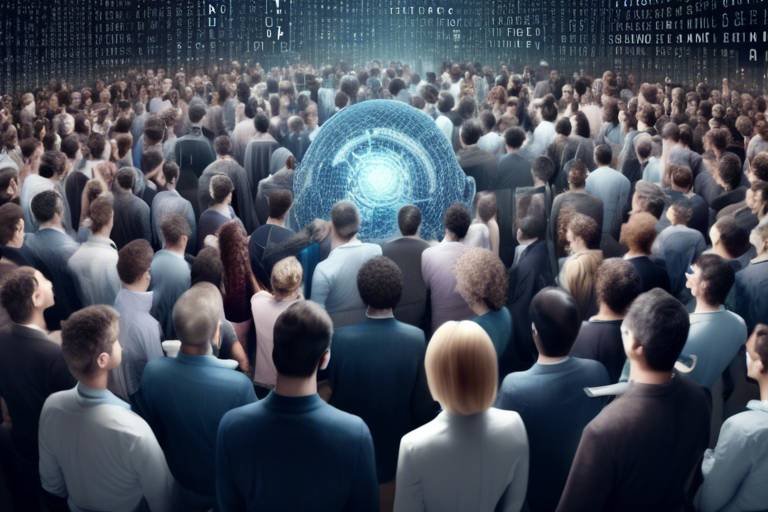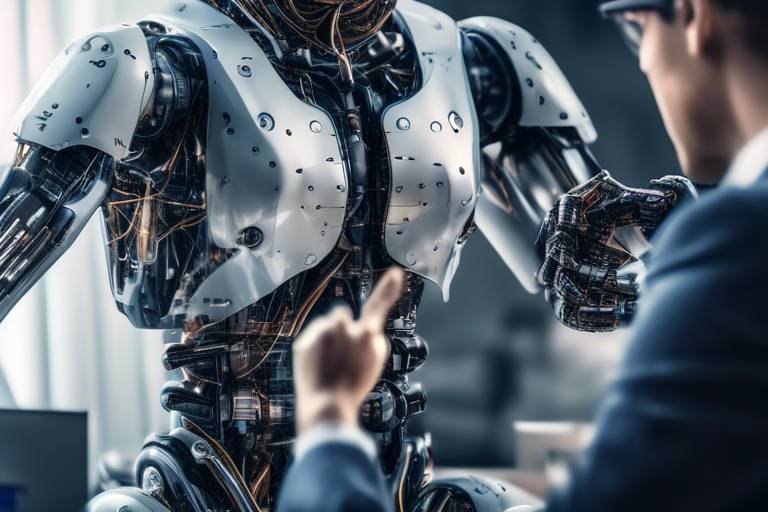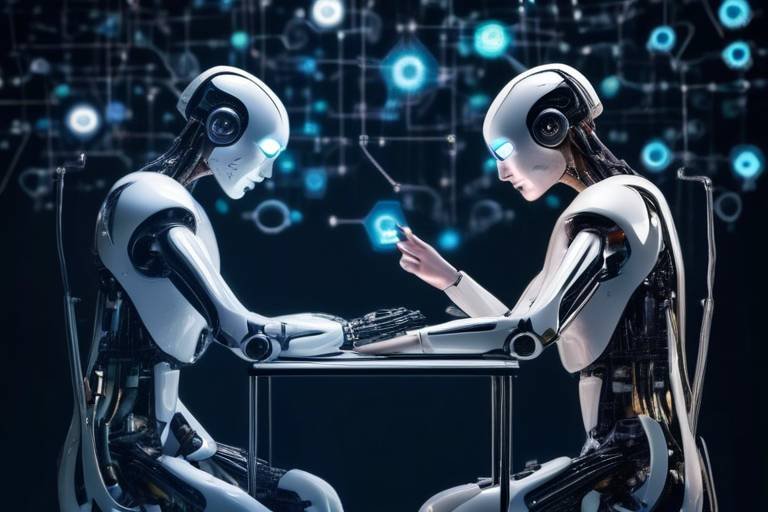The Power Couple: AI and Humans in Collaboration
In a world where technology is evolving at lightning speed, the partnership between artificial intelligence (AI) and humans is becoming increasingly vital. Imagine a dance where each partner brings their unique strengths to the floor, creating a performance that neither could achieve alone. This dynamic collaboration has the potential to revolutionize various sectors, from healthcare to education, enhancing our capabilities while also presenting new challenges. As we delve into this fascinating relationship, we’ll explore how AI complements human creativity, the benefits and challenges of their collaboration, and what the future holds for this powerful duo.
The journey of artificial intelligence is a tale of innovation and discovery that dates back to the mid-20th century. Initially, AI was a mere concept, a dream that scientists and researchers aspired to bring to life. Over the decades, we have witnessed key milestones that have propelled AI from theoretical discussions to practical applications. From the development of the first neural networks in the 1950s to the advent of machine learning and deep learning, AI has undergone a remarkable transformation. Today, AI systems are capable of performing complex tasks, learning from data, and even engaging in conversations that feel surprisingly human-like. This evolution has set the stage for a collaborative relationship that enhances both human and machine capabilities.
While AI excels in processing vast amounts of data and performing calculations at incredible speeds, it is the human touch that adds depth and creativity to problem-solving. Think of AI as a powerful calculator that can crunch numbers faster than any human, but it lacks the imagination to envision the bigger picture. This is where humans come in, infusing creativity and intuition into the process. For instance, in industries like marketing, AI can analyze consumer behavior and predict trends, but it takes a human to craft compelling narratives that resonate with audiences. This synergy between AI's analytical prowess and human creativity not only enhances innovation but also drives solutions that are both effective and empathetic.
As we step into the future of work, AI tools are becoming integral to various job sectors. The integration of AI into the workplace is not about replacing human workers; rather, it’s about enhancing productivity and automating repetitive tasks. For example, in customer service, AI chatbots can handle basic inquiries, allowing human agents to focus on more complex issues that require emotional intelligence and critical thinking. This shift is reshaping traditional roles, creating new opportunities for collaboration. Employees are now empowered to leverage AI to augment their skills, leading to a more efficient and innovative work environment.
In the realm of healthcare, AI is proving to be a game-changer. From improving diagnostics to streamlining patient care, AI technologies are assisting healthcare professionals in ways previously thought impossible. Imagine a scenario where an AI system analyzes medical images with greater accuracy than a human radiologist. However, while AI can provide insights and recommendations, it is the human element—empathy, ethical considerations, and decision-making—that remains irreplaceable in treatment processes. The collaboration between AI and healthcare professionals not only enhances operational efficiency but also ensures that patient care remains compassionate and personalized.
The educational landscape is also undergoing a transformation thanks to AI. Personalized learning experiences powered by AI algorithms enable educators to tailor their teaching methods to meet the unique needs of each student. Imagine a classroom where AI analyzes a student's learning style and adapts lessons accordingly. However, the presence of human educators is crucial in guiding and mentoring students, providing the encouragement and support that AI simply cannot offer. This partnership between AI and teachers fosters an environment where students can thrive, paving the way for a more engaged and informed generation.
As we embrace the collaboration between AI and humans, it is essential to address the ethical implications that arise. Concerns about bias in AI algorithms, privacy issues, and accountability are critical topics that need careful consideration. Establishing guidelines to ensure responsible use of AI technologies is paramount in fostering a healthy partnership. The goal is to create a framework where AI serves humanity without compromising ethical standards, ensuring that the benefits of this collaboration are shared equitably across society.
Despite the promising potential of AI-human collaboration, several challenges must be addressed. Resistance to change, skill gaps, and the fear of job displacement are common hurdles that organizations face. Overcoming these challenges requires a proactive approach, including ongoing education and training to equip workers with the skills needed to thrive in an AI-enhanced environment. By fostering a culture of adaptability and continuous learning, organizations can pave the way for a successful partnership between AI and humans.
For AI-human collaboration to flourish, establishing trust is crucial. Transparency, reliability, and user education are key factors in building this trust. When individuals understand how AI systems work and can see their benefits firsthand, they are more likely to embrace these technologies. Trust is the foundation upon which successful collaboration is built, and as we navigate this new landscape, it is essential to prioritize open communication and education.
Looking ahead, the future of AI-human collaboration is brimming with possibilities. Emerging technologies such as augmented reality and advanced robotics are set to further enhance this partnership. As roles evolve, we may see new job categories emerge that focus on managing and optimizing AI systems. The key will be to harness these advancements in a way that benefits society as a whole, ensuring that the collaboration between AI and humans leads to a brighter, more innovative future.
- What is the main benefit of AI-human collaboration? The main benefit is the combination of AI's analytical capabilities with human creativity, leading to enhanced problem-solving and innovation.
- How does AI impact job roles? AI automates repetitive tasks, allowing humans to focus on more complex and creative aspects of their jobs, potentially creating new roles in the process.
- What are the ethical concerns surrounding AI? Key concerns include bias, privacy, accountability, and the need for responsible use of AI technologies.
- How can trust in AI be established? Trust can be built through transparency, reliability, and educating users about how AI systems function and their benefits.

The Evolution of AI
The journey of artificial intelligence (AI) is nothing short of fascinating, akin to a thrilling roller coaster ride through the realms of technology and human ingenuity. From its humble beginnings in the mid-20th century to the sophisticated systems we see today, AI has evolved dramatically, showcasing a series of milestones that have fundamentally transformed its capabilities and applications.
AI's roots can be traced back to the 1950s, when pioneers like Alan Turing and John McCarthy laid the groundwork for machine learning and cognitive computing. Turing's famous question, "Can machines think?" sparked a wave of curiosity and research that continues to this day. The term "artificial intelligence" was officially coined in 1956 at the Dartmouth Conference, marking the beginning of a new era in computer science.
Throughout the 1960s and 1970s, AI research flourished, leading to the development of early AI programs like ELIZA, which simulated conversation, and DENDRAL, a program designed for chemical analysis. These innovations opened doors to further exploration, but the journey wasn't without its challenges. The AI winter periods of the late 1970s and late 1980s, characterized by reduced funding and interest, tested the resilience of the field.
However, the resurgence of AI in the 1990s was fueled by advancements in computational power and the advent of the internet. The introduction of machine learning techniques, particularly neural networks, allowed computers to learn from vast amounts of data. This period also witnessed significant achievements, such as IBM's Deep Blue defeating world chess champion Garry Kasparov in 1997, showcasing AI's potential in complex problem-solving.
The 21st century has seen an explosion in AI capabilities, driven by the availability of big data and advancements in algorithms. Technologies such as deep learning and natural language processing have enabled AI to excel in tasks ranging from image recognition to language translation. Companies like Google, Facebook, and Amazon have harnessed AI to enhance user experiences, optimize operations, and drive innovation.
Today, AI is not just a concept; it’s an integral part of our daily lives, influencing everything from how we interact with our devices to how businesses operate. The evolution of AI has created a landscape where collaboration between humans and machines is not only possible but essential. This partnership opens up exciting possibilities for the future, but it also raises important questions about ethics, trust, and the role of human creativity in an increasingly automated world.
In summary, the evolution of AI has been a remarkable journey filled with challenges and triumphs. As we look ahead, it is crucial to understand the historical context of AI development to fully appreciate its potential and navigate the complexities of AI-human collaboration. The next sections will delve deeper into how human creativity complements AI's analytical strengths and the implications of this powerful partnership.
- What is the origin of artificial intelligence? AI originated in the 1950s, with significant contributions from pioneers like Alan Turing and John McCarthy.
- What are some key milestones in AI development? Key milestones include the Dartmouth Conference in 1956, the creation of ELIZA in the 1960s, and IBM's Deep Blue defeating Garry Kasparov in 1997.
- How has AI changed in the 21st century? The 21st century has seen rapid advancements due to big data and machine learning, making AI a part of everyday life.
- What role does human creativity play in AI? Human creativity complements AI's analytical abilities, enhancing problem-solving and innovation across various sectors.

The Role of Human Creativity
When we think of artificial intelligence, we often picture machines crunching numbers at lightning speed or algorithms analyzing data in ways that leave us in awe. However, the true magic happens when we blend this computational prowess with the boundless creativity of humans. It's like mixing the precision of a surgeon's scalpel with the artistry of a painter's brush—each one enhances the other, creating something far greater than the sum of its parts.
Human creativity is a unique trait that allows us to envision possibilities beyond the mundane. While AI can process information and recognize patterns, it lacks the emotional depth and imaginative spark that humans possess. Think of it this way: AI can tell you what has happened based on data, but it takes a human to dream about what could be. This is where the collaboration between AI and humans truly shines.
In various industries, we see how human creativity complements AI's analytical strengths. For instance, in marketing, AI can analyze consumer behavior, but it takes a human touch to craft compelling narratives that resonate with audiences. Similarly, in product design, AI can optimize for functionality and efficiency, but only humans can infuse designs with cultural relevance and emotional appeal.
Moreover, the integration of AI into creative processes has led to some fascinating outcomes. Consider the world of music and art. AI algorithms can generate melodies or create visual art pieces, but the most captivating works often arise from the collaboration between artists and AI. Artists can use AI as a tool to explore new styles or generate ideas, while still injecting their personal flair and emotional resonance into the final product.
Yet, it is crucial to recognize that the role of human creativity in AI-driven processes is not merely about enhancing outputs; it is also about ensuring that the technology aligns with human values and ethics. For example, when developing AI systems for healthcare, human creativity plays a vital role in designing solutions that prioritize patient care and ethical considerations. This partnership ensures that AI serves humanity's best interests rather than just optimizing for efficiency.
As we look to the future, the synergy between AI and human creativity holds immense potential. Imagine a world where AI assists in scientific research, helping scientists to identify patterns in complex data sets, while researchers apply their creative thinking to formulate groundbreaking hypotheses. This collaboration could accelerate discoveries in fields like medicine, environmental science, and technology.
In conclusion, the role of human creativity in the age of AI is not just significant; it is essential. By embracing our creative capabilities and leveraging AI's analytical strengths, we can tackle the challenges of tomorrow with innovative solutions that reflect our shared humanity. The partnership between AI and humans is not just a trend; it's a transformative journey that promises to reshape our world in ways we are only beginning to understand.
- How does AI enhance human creativity? AI can analyze large data sets and generate ideas, providing a foundation for human creators to build upon and innovate further.
- Can AI create art or music independently? While AI can generate art and music, the most compelling works often result from collaboration with human artists who add emotional depth and context.
- What industries benefit most from the collaboration between AI and human creativity? Industries such as marketing, healthcare, design, and scientific research are seeing significant benefits from this partnership.
- Will AI replace human creativity? No, AI is a tool that can enhance creativity, but it cannot replicate the emotional and imaginative aspects that define human creativity.

The integration of artificial intelligence (AI) into the workplace is reshaping how we approach our daily tasks and responsibilities. Imagine walking into your office, greeted not just by your colleagues but also by intelligent systems that can analyze data, automate repetitive tasks, and even predict project outcomes. This is not science fiction; it’s the reality of modern work environments. AI is becoming a vital partner for humans, enhancing productivity and enabling us to focus on what we do best—creative thinking and problem-solving.
One of the most significant advantages of AI in the workplace is its ability to automate mundane tasks. Think about it: how much time do you spend on repetitive activities like data entry or scheduling meetings? AI tools can take over these tasks, allowing employees to redirect their energy towards more strategic initiatives. For instance, chatbots can handle customer inquiries, freeing up human agents to tackle complex issues that require emotional intelligence and nuanced understanding. This shift not only improves efficiency but also boosts employee morale, as people feel more engaged when they can contribute meaningfully to their organizations.
Moreover, AI's analytical prowess is a game changer. By processing vast amounts of data at lightning speed, AI can uncover insights that would take humans much longer to identify. For example, in marketing, AI algorithms can analyze consumer behavior patterns and predict future trends, enabling businesses to tailor their strategies effectively. This level of data-driven decision-making empowers teams to make informed choices, enhancing the overall success of projects.
However, the integration of AI is not without its challenges. It necessitates a cultural shift within organizations. Many employees may feel threatened by the introduction of AI, fearing that it could lead to job displacement. To address these concerns, companies must foster a culture of collaboration rather than competition between humans and AI. This involves training programs that help employees understand and leverage AI tools, transforming them from potential adversaries into valuable allies.
In addition to enhancing productivity and innovation, AI can also contribute to workplace diversity. AI systems can help eliminate biases in hiring processes by analyzing candidates based on their skills and experiences rather than subjective criteria. This can lead to a more inclusive workforce, which is essential for fostering creativity and driving business success. However, it’s crucial to ensure that the AI systems themselves are free from biases, as flawed algorithms can perpetuate existing inequalities.
To illustrate the impact of AI in various sectors, consider the following table showcasing different AI applications across industries:
| Industry | AI Application | Benefits |
|---|---|---|
| Healthcare | Diagnostic tools | Improved accuracy and faster patient care |
| Finance | Fraud detection | Enhanced security and reduced losses |
| Retail | Personalized recommendations | Increased customer satisfaction and sales |
| Manufacturing | Predictive maintenance | Reduced downtime and maintenance costs |
As we look to the future, it’s clear that AI will continue to play a pivotal role in shaping the workplace. By embracing this technology, organizations can unlock new levels of efficiency and creativity. The key to success lies in fostering a collaborative environment where humans and AI can work hand in hand, leveraging each other's strengths to achieve remarkable outcomes.
In conclusion, the partnership between AI and humans in the workplace is not just about technology; it’s about enhancing our abilities, improving our work lives, and ultimately creating a more innovative and efficient future. As we navigate this exciting landscape, we must remember that while AI can do many things, it is the human touch that adds value, empathy, and creativity to our work.

AI in Healthcare
Artificial Intelligence (AI) is revolutionizing the healthcare industry in ways we could only dream of a few decades ago. Imagine a world where diagnostics are faster, treatments are more personalized, and patient care is enhanced by technology that learns and adapts. This is not just a fantasy; it’s happening right now. AI algorithms are sifting through vast amounts of medical data, identifying patterns that even the most experienced professionals might miss. With this powerful tool at their disposal, healthcare providers can make more informed decisions, leading to better patient outcomes.
One of the most significant impacts of AI in healthcare is in the realm of diagnostics. Traditional diagnostic methods can be time-consuming and sometimes inaccurate. However, AI systems can analyze medical images, such as X-rays and MRIs, with remarkable precision. For instance, studies have shown that AI can match or even surpass human radiologists in detecting certain conditions, like tumors. This capability not only speeds up the diagnostic process but also reduces the chances of human error, which can be life-threatening.
Furthermore, AI is enhancing patient care by enabling personalized treatment plans. By analyzing data from various sources, including genetic information, lifestyle factors, and medical history, AI can help healthcare providers tailor treatments to individual patients. This personalized approach ensures that patients receive the most effective therapies based on their unique profiles, ultimately improving their chances of recovery.
In addition to diagnostics and personalized care, AI is also streamlining operations within healthcare facilities. For instance, AI-powered chatbots are being used to handle administrative tasks, such as scheduling appointments and answering common patient inquiries. This automation allows healthcare professionals to focus more on patient care rather than paperwork, thus enhancing overall efficiency.
However, while AI offers immense benefits, it is crucial to remember that human empathy and decision-making remain irreplaceable. Machines may excel at processing data, but they lack the emotional intelligence that is essential in healthcare. For example, when delivering bad news or discussing treatment options, the human touch is vital. Patients often need reassurance and compassion, qualities that AI cannot provide. Therefore, the collaboration between AI and healthcare professionals is not about replacing humans but rather augmenting their capabilities.
In summary, the integration of AI in healthcare is a game-changer. It enhances diagnostics, personalizes patient care, and streamlines operations, ultimately leading to better health outcomes. Yet, the human element remains essential in this partnership. As we move forward, it’s crucial to strike a balance between leveraging AI's strengths and ensuring that the compassion inherent in healthcare is preserved.
- How does AI improve diagnostics in healthcare?
AI analyzes medical images and data to identify patterns and anomalies more quickly and accurately than traditional methods. - Can AI replace doctors?
No, AI complements healthcare professionals by providing data-driven insights, but the human touch remains essential in patient care. - What are the ethical concerns surrounding AI in healthcare?
Concerns include data privacy, potential biases in AI algorithms, and the need for transparency in AI decision-making processes. - How is patient data protected when using AI?
Healthcare organizations must adhere to strict regulations, such as HIPAA, to ensure patient data is kept secure and private.

AI in Education
Artificial Intelligence (AI) is revolutionizing the educational landscape, transforming how students learn and how educators teach. Imagine a classroom where each student has a personalized tutor, available 24/7, adapting to their unique learning style and pace. This is not just a dream; it’s a reality made possible by AI technologies. From intelligent tutoring systems to automated administrative tasks, AI is enhancing educational experiences and making learning more accessible than ever.
One of the standout features of AI in education is its ability to provide personalized learning experiences. Traditional classrooms often struggle to cater to the diverse needs of students. However, AI can analyze individual performance data and tailor lessons accordingly. For instance, if a student excels in mathematics but struggles with reading comprehension, AI systems can adjust the curriculum, providing more resources and exercises in reading while allowing the student to advance in math. This level of customization not only boosts student engagement but also fosters a deeper understanding of the material.
Moreover, AI can significantly reduce the administrative burden on educators. Tasks such as grading assignments, tracking attendance, and managing schedules can be automated, allowing teachers to focus more on what they do best: teaching. Consider the time saved when a teacher no longer has to spend hours grading papers manually. Instead, they can invest that time in developing innovative lesson plans or providing one-on-one support to students who need it. This shift not only enhances teacher productivity but also improves the overall quality of education.
However, the integration of AI in education is not without its challenges. While AI can provide valuable insights and support, it cannot replace the human touch that is crucial in education. Educators play a vital role in mentoring, inspiring, and connecting with students on a personal level. The emotional intelligence and empathy of a teacher are irreplaceable, making the partnership between AI and human educators essential. Therefore, while AI can handle data and analytics, it’s the teachers who bring passion and understanding to the learning process.
As we look to the future, the potential of AI in education is vast. With ongoing advancements, we can expect to see even more sophisticated AI tools that further enhance learning experiences. For example, AI could facilitate virtual reality classrooms where students can explore historical events or scientific phenomena in immersive environments. This kind of engagement could lead to deeper learning and retention of knowledge.
In conclusion, AI is not just a technological innovation; it’s a powerful ally in the quest for educational excellence. By harnessing the strengths of AI and combining them with the irreplaceable qualities of human educators, we can create a learning environment that is not only effective but also enriching. The future of education lies in collaboration, where AI and humans work hand in hand to inspire and educate the next generation.
- How does AI personalize learning experiences? AI analyzes student data to tailor educational content to individual learning styles and paces.
- Can AI replace teachers? No, while AI can assist with administrative tasks and provide personalized resources, the human touch of educators is irreplaceable.
- What are some examples of AI tools in education? Examples include intelligent tutoring systems, automated grading software, and learning management systems that adapt to student needs.
- How does AI improve administrative efficiency? AI automates tasks such as grading, attendance tracking, and scheduling, allowing teachers to focus more on teaching.

The Ethical Considerations
As we dive deeper into the world of artificial intelligence, it's crucial to shine a light on the ethical considerations that come along with this powerful technology. The partnership between AI and humans is not merely about efficiency and productivity; it also raises significant questions about bias, privacy, and accountability. These issues are not just technical problems; they are deeply rooted in our society and demand our attention.
For instance, consider bias in AI algorithms. If the data fed into these systems is skewed or not representative of the broader population, the AI can perpetuate or even exacerbate existing inequalities. A classic example is the use of facial recognition technology, which has been shown to misidentify individuals from minority groups at a higher rate than others. This not only leads to unfair treatment but also raises questions about the human oversight required to mitigate such biases. How can we trust a system that may inadvertently discriminate against certain individuals?
In addition to bias, privacy concerns are paramount. As AI systems collect vast amounts of data to function effectively, the potential for misuse of personal information looms large. People often wonder: who owns this data? How is it being used? Are we sacrificing our privacy for the sake of convenience? These are questions that must be answered to build a responsible framework for AI deployment.
Moreover, accountability is another critical aspect of ethical AI use. When an AI system makes a mistake, such as an erroneous medical diagnosis or a flawed financial decision, who is responsible? Is it the developers, the company, or the AI itself? Establishing clear accountability measures is essential to ensure that there are consequences for errors and that users can have faith in the systems they interact with.
To address these ethical considerations, it is vital to establish guidelines and frameworks that promote responsible AI use. Here are some key areas that need attention:
- Transparency: AI systems should be designed to be transparent, allowing users to understand how decisions are made.
- Inclusivity: Diverse teams should be involved in AI development to ensure that various perspectives are considered, reducing the risk of bias.
- Accountability: Clear lines of accountability must be established, ensuring that users know who to turn to when things go wrong.
As we move forward in this AI-driven world, it's essential to remember that technology should serve humanity, not the other way around. By addressing these ethical considerations head-on, we can foster a collaborative environment where both AI and humans thrive together, paving the way for a future that is not only innovative but also just and equitable.
Q1: What are the main ethical concerns regarding AI?
A1: The main ethical concerns include bias, privacy, and accountability. It's essential to ensure that AI systems do not perpetuate existing inequalities, respect personal data, and have clear lines of responsibility for their actions.
Q2: How can we mitigate bias in AI?
A2: Mitigating bias in AI can be achieved by using diverse datasets, involving diverse teams in the development process, and implementing ongoing monitoring to identify and correct biases as they arise.
Q3: Why is transparency important in AI?
A3: Transparency is crucial because it allows users to understand how AI systems make decisions, fostering trust and enabling accountability for errors and biases.

Challenges in Collaboration
The collaboration between artificial intelligence (AI) and humans is not without its challenges. As we stand on the brink of an era where these two forces intertwine, it’s crucial to recognize the hurdles that can impede their partnership. One of the most significant challenges is the resistance to change. Many individuals and organizations are hesitant to embrace AI technologies due to fear of the unknown. This reluctance can stem from a lack of understanding of AI's capabilities or the potential impact on job roles. It’s like trying to convince a cat to take a bath—there’s an innate resistance that must be overcome.
Another pressing issue is the skills gap. As AI systems evolve, the demand for skilled workers who can effectively interact with these technologies increases. Unfortunately, not everyone possesses the necessary skills to thrive in an AI-driven environment. This gap can lead to frustration and inefficiency, much like trying to fit a square peg into a round hole. Organizations need to invest in training programs that equip their workforce with the skills needed to collaborate effectively with AI.
Moreover, there’s the looming concern of job displacement. While AI has the potential to create new opportunities, it also poses a threat to traditional roles. Workers may fear that their jobs will be automated, leading to anxiety about job security. It’s essential for companies to communicate transparently about how AI will be integrated into their operations. By doing so, they can alleviate fears and foster a culture of collaboration rather than competition.
To navigate these challenges, organizations can adopt several strategies:
- Education and Training: Providing ongoing education and training ensures that employees feel confident in their ability to work alongside AI.
- Open Communication: Establishing a culture of transparency where employees can voice their concerns about AI integration is vital.
- Gradual Implementation: Introducing AI tools gradually can help ease the transition and allow employees to adapt.
Lastly, the potential for ethical dilemmas cannot be overlooked. As AI systems are designed to make decisions, questions arise about accountability and fairness. For instance, if an AI system makes a biased decision, who is responsible? This ambiguity can create tension in the collaboration. To address this, it’s crucial to develop clear guidelines that govern the ethical use of AI technologies. This will ensure that both humans and AI can work together harmoniously, with a shared understanding of their roles and responsibilities.
- What are the main challenges in AI-human collaboration? The main challenges include resistance to change, skills gaps, job displacement, and ethical dilemmas.
- How can organizations overcome resistance to change? Organizations can overcome resistance by providing education, fostering open communication, and gradually implementing AI technologies.
- Why is the skills gap a concern in AI integration? The skills gap is concerning because it can lead to frustration and inefficiency, making it difficult for employees to collaborate effectively with AI.
- What ethical considerations should be taken into account? Ethical considerations include accountability for AI decisions, potential biases, and the need for clear guidelines governing AI use.

Building Trust in AI
Trust is the cornerstone of any successful relationship, and the partnership between humans and artificial intelligence (AI) is no exception. As we dive deeper into the era of AI, establishing a strong foundation of trust becomes paramount. But how do we build this trust? It starts with transparency. When AI systems operate in a "black box," users are left in the dark, leading to skepticism and fear. By making the algorithms and decision-making processes clear, we can demystify AI and foster a sense of confidence among users.
Another crucial aspect is reliability. Just like a trusted friend, AI systems must consistently deliver accurate and dependable results. If users experience discrepancies or errors, their trust erodes rapidly. Therefore, rigorous testing and validation of AI systems are essential to ensure they perform as expected. Moreover, user education plays a vital role. When individuals understand how AI works and its limitations, they are more likely to embrace it rather than fear it. This educational aspect can be achieved through workshops, online courses, and comprehensive user manuals.
Let's consider a few key factors that contribute to building trust in AI:
- Transparency: Openly sharing how AI systems work and make decisions.
- Reliability: Ensuring consistent and accurate performance of AI tools.
- User Education: Providing resources to help users understand AI technology.
Moreover, ethical considerations cannot be overlooked. AI systems must be designed with fairness in mind, avoiding biases that could lead to unjust outcomes. This means implementing guidelines and regular audits to ensure that AI behaves ethically. If users perceive that AI is fair and just, their trust will naturally increase. In addition, accountability is crucial. When AI systems make decisions, there should always be a human in the loop who can take responsibility for the outcomes. This human oversight not only enhances trust but also reinforces the idea that AI is a tool to assist, not replace, human judgment.
In conclusion, building trust in AI is a multifaceted endeavor that requires transparency, reliability, education, ethical design, and accountability. As we continue to integrate AI into our lives, fostering this trust will be essential for maximizing the benefits of this powerful technology. With a strong foundation of trust, the collaboration between humans and AI can flourish, leading to innovative solutions and transformative advancements across various sectors.
- What is the main challenge in building trust in AI? The primary challenge lies in ensuring transparency and reliability in AI systems, as users tend to distrust systems they do not understand.
- How can user education improve trust in AI? By educating users about how AI works and its limitations, they can better understand the technology, which fosters confidence in its use.
- Why is ethical design important in AI? Ethical design helps prevent biases and ensures fair outcomes, which are crucial for maintaining user trust.

Future Trends in AI-Human Collaboration
As we look ahead, the landscape of AI-human collaboration is poised for remarkable transformation. With the rapid advancement of technology, the synergy between humans and artificial intelligence is expected to evolve in ways we can only begin to imagine. One of the most exciting trends is the rise of augmented intelligence, where AI systems are designed not to replace human jobs but to enhance human capabilities. This means that rather than seeing AI as a competitor, we will increasingly view it as a powerful tool that amplifies our strengths.
Imagine a world where AI not only handles tedious tasks but also collaborates with us in creative endeavors. For instance, in fields like design and marketing, AI can analyze vast amounts of data to identify trends and preferences, while humans can leverage their creativity to develop innovative concepts. This partnership can lead to groundbreaking ideas that neither could achieve alone. As we embrace this collaborative spirit, we can expect to see more user-friendly interfaces that allow for seamless interaction between human intuition and AI logic.
Moreover, the integration of AI into daily workflows is likely to become more sophisticated. In the workplace, we'll see AI systems that are not just tools but partners that adapt to our working styles and preferences. These systems will learn from our interactions, providing personalized recommendations that can boost productivity and job satisfaction. Picture an AI assistant that understands your work habits, suggests optimal schedules, and even helps prioritize tasks based on your goals. This level of customization will redefine the way we work and collaborate.
In the realm of healthcare, AI will continue to play a pivotal role in enhancing patient outcomes. We can expect to see more advanced diagnostic tools that not only analyze medical data but also assist healthcare professionals in making informed decisions. However, the human touch will remain irreplaceable. The ability to empathize, communicate, and understand patient needs will always be a domain where humans excel. Thus, the future of healthcare will be characterized by a harmonious blend of AI efficiency and human compassion.
Furthermore, as AI becomes more integrated into our lives, ethical considerations will take center stage. The need for transparency in AI systems will be crucial. Future AI technologies will likely come equipped with features that allow users to understand how decisions are made, fostering trust and accountability. This transparency will empower users to engage with AI systems confidently, knowing that their data is handled responsibly and ethically.
As we navigate these exciting changes, it’s essential to consider the implications for education. The role of educators will evolve, with AI providing personalized learning experiences tailored to individual students’ needs. Teachers will become facilitators, guiding students through complex concepts while AI handles the heavy lifting of data analysis and resource allocation. This partnership will create a more engaging and effective learning environment.
In conclusion, the future of AI-human collaboration is bright and filled with potential. By embracing these trends, we can harness the best of both worlds—human creativity and emotional intelligence combined with AI's analytical prowess. As we move forward, the key will be to foster an environment where this collaboration flourishes, leading to innovations that enhance our lives and reshape our society.
- What is augmented intelligence? Augmented intelligence refers to the use of AI technologies to enhance human intelligence and decision-making, rather than replacing human roles.
- How will AI impact job roles in the future? AI is expected to automate routine tasks, allowing humans to focus on more complex and creative aspects of their jobs, ultimately creating new opportunities.
- What ethical considerations should we keep in mind with AI? Key ethical considerations include bias in AI algorithms, data privacy, and the need for transparency in AI decision-making processes.
- How can AI be used in education? AI can personalize learning experiences, automate administrative tasks, and provide insights into student performance, allowing educators to focus on mentorship.
Frequently Asked Questions
- What is the collaboration between AI and humans?
The collaboration between AI and humans refers to the partnership where both entities leverage their strengths to achieve better outcomes. While AI excels in processing large amounts of data and performing repetitive tasks, humans bring creativity, emotional intelligence, and critical thinking to the table. Together, they can tackle complex problems more effectively than either could alone.
- How has AI evolved over the years?
AI has undergone significant evolution since its inception in the mid-20th century. Key milestones include the development of neural networks, the introduction of machine learning algorithms, and the rise of deep learning techniques. Each breakthrough has expanded AI's capabilities, enabling it to perform tasks ranging from image recognition to natural language processing, making it a powerful tool across various sectors.
- What role does human creativity play in AI?
Human creativity is crucial in AI development and application. While AI can analyze data and identify patterns, it lacks the ability to think outside the box or come up with innovative ideas. Humans provide the creative spark needed to guide AI in solving problems, designing new products, and enhancing user experiences, ensuring that technology serves our needs effectively.
- How is AI changing the workplace?
AI is transforming the workplace by automating mundane tasks, enhancing productivity, and reshaping job roles. For instance, AI tools can handle data entry, scheduling, and customer inquiries, allowing employees to focus on more strategic and creative aspects of their work. This shift not only boosts efficiency but also opens up new opportunities for collaboration and innovation.
- What are the ethical concerns related to AI?
Ethical concerns surrounding AI include issues of bias, privacy, and accountability. As AI systems are trained on historical data, they can inadvertently perpetuate existing biases, leading to unfair outcomes. Additionally, the use of AI in decision-making raises questions about who is responsible for those decisions. Establishing guidelines and frameworks is essential to ensure that AI technologies are used responsibly and ethically.
- What challenges do we face in AI-human collaboration?
Challenges in AI-human collaboration include resistance to change, skill gaps, and fears of job displacement. Many individuals may be hesitant to adopt new technologies, while others may lack the necessary skills to work alongside AI systems. Addressing these challenges through education, training, and clear communication is vital for fostering effective collaboration and maximizing the benefits of AI.
- How can we build trust in AI systems?
Building trust in AI systems requires transparency, reliability, and user education. Users need to understand how AI systems make decisions and the data they rely on. Providing clear information about the algorithms and ensuring consistent performance can help foster trust. Additionally, educating users about the capabilities and limitations of AI is crucial for successful collaboration.
- What are the future trends in AI-human collaboration?
The future of AI-human collaboration is likely to be shaped by emerging technologies such as advanced machine learning, natural language processing, and robotics. These advancements will create new roles and opportunities for collaboration, allowing humans and AI to work together more seamlessly. As technology evolves, the focus will shift towards enhancing human capabilities and ensuring that AI serves as a supportive partner in various fields.

